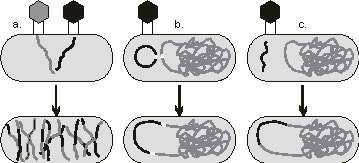Proteins gradually evolve by accumulating different kinds of mutations over eons of time. But mutation is not the only source of genetic diversity. In the remainder of this section other important genetic operators are presented. One such operator is recombination. In nature there are varied kinds of recombinational processes, involved in different processes and playing different functions. However, during all recombinational processes some fragments of genetic material are exchanged between two distinct donor molecules, as such that genetic information from each donor is present in the offspring
(Figure 1.4). For example, during sexual reproduction two paired homologous chromosomes exchange DNA fragments.

Figure 1.4. Three recombinational processes: a) homologous recombination;
b) site-specific recombination; and c) non-homologous recombination. Note that the transforming power of site-specific recombination and non-homologous recombination is much more profound than homologous recombination.
The simple image of homologous recombination where homologous chromosomes (chromosomes with extensive sequence homology) are paired, can be useful to help understand the recombinational processes used to create genetic diversity in GEP populations, although in the latter case no sequence homology is required. This simple image is nonetheless very handy, because, in GEP, recombining chromosomes share a structural homology and also because two new daughter chromosomes are created in the process. Thus, during recombination, two chromosomes (not necessarily homologous) are paired and exchange some material between them, forming two new daughter chromosomes. Note, however, that due to the structural homology, a fragment of a particular gene occupying a particular position in the chromosome is never exchanged for a fragment of a gene in a different position; or a fragment of the gene tail is never exchanged for a fragment of the head. In this sense, note that GEP recombination has no counterpart in biology despite its apparent resemblance to homologous recombination.
|
